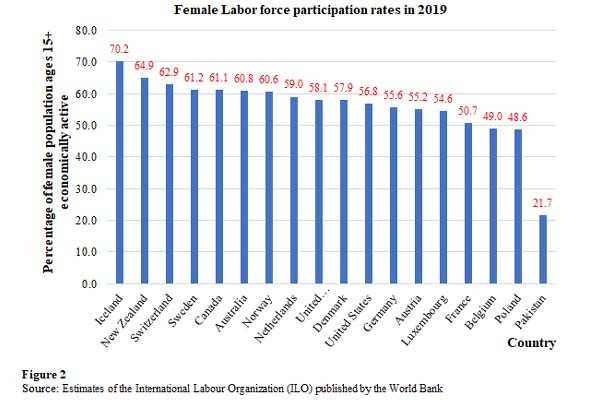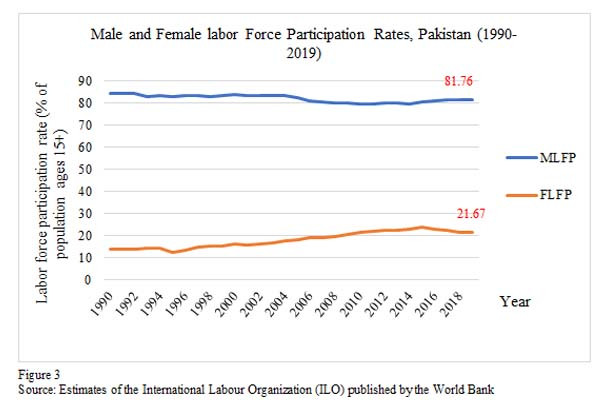
How to increase female labour force participation in Pakistan
The labour force participation rates of women in Pakistan are amongst the lowest in the world. The graph below shows the trends in Female Labour Force Participation (FLFP) in Pakistan and its neighbouring countries in South Asia including Nepal, Bhutan, Sri Lanka, Bangladesh, India and Afghanistan. As the estimates show, the percentage of economically active women aged 15 and above is 21.67 percent in Pakistan, which is among the lowest in the region. The estimated participation rates of women in neighbouring Afghanistan have caught up and now marginally exceed the FLFP rate in Pakistan.

Figure 2 below shows FLFP rates for selected high-income countries in Europe, North America, Australia, New Zealand, and Pakistan. The graph speaks for itself; FLFP rates in Pakistan are very low; FLFP rates in high-income countries range between 70-50 percent.

A comparison of the trends in labour force participation of men and women may also be instructive. FP rates in Pakistan can also be compared with the male labour force participation rates. These are shown in Figure 3 below. While the MLFP rate has stayed above 80 percent throughout the past two decades, the FLFP peaked at a mere 24 percent in the year 2015.

Why should Pakistan’s low FLFP rate be of concern? Harvard economist, Claudia Goldin in her research on the effect of women’s participation in the labour force in the United States over a period of 9 decades (1890-1980) estimated that “the labour force participation rate of prime-aged females (15-64 years old) rose from 19.6% in 1890 to 59.9% in 1980”. She estimated the effect of this increase on economic activity and estimated that “had the female labour force not expanded over this period, national income per capita would probably have been at least 14% lower than it actually was.” More recent estimates from economists at the Hamilton Project suggest that if the FLFP rate in the US had increased as much as the FLFP rate in Japan between 2000-2016, “GDP in the United States would have been around $800 billion (over 4%) higher in 2016 than it actually was, increasing GDP per person by nearly $2,500.” Women’s exclusion from the labour force harms the economy. The large gains in terms of economic output notwithstanding, women’s access to paid work and women’s own incomes has been evidenced to increase women’s bargaining power within households leading to several positive changes including improving women’s own and children’s health and nutrition and children’s schooling. To say that these positive effects go a long way towards sustainable economic development is only tautological.
What can Pakistan learn from the rest of the world in order to encourage women to play a key role in the labour force? We look at some of the key factors that have led an increase in the FLFP in high-income countries in North America and Europe. These include: structural change, fertility and access to contraception, household labour saving technology, child-care policies, mobility, education and social norms.
Structural factors
Among the most widely tested hypothesis on FLFP is the non-linear (U-Shaped) relationship between economic growth and the FLFP rate. At low levels of household income, both men and women in households (and even children) participate in the labour force. With a higher rate of growth in economies, characterised by high rates of employment and high household incomes, women withdraw from the labour force. This pattern has been observed in Pakistan whereby women belonging to low-income households in the rural areas actively participating as wage labourers or family workers in the agricultural sector. An increase in household income due to any factor leads to women withdrawing from engaging in this work. Stephen Klasen and Janneke Pieters observe a similar trend in India, “rising male incomes and education have reduced female labour force participation, showing that the classic income effect is at work in urban India”. However, according to this U-shaped hypothesis, a period of sustained economic growth with rinsing incomes and accompanying increase in the education levels of the populations, women are drawn into the labour force increasing the FLFP rates as are now observed in almost all high-income countries.
Another change in the structures of economies that has been evidenced to have impacted women’s participation in the labour force is the relative size of its sectors. As economies grow, the share of the services sector in the economies also increases as increase in household incomes leads to an increase in demand for services. This shift leads to an increase in jobs in the services sector. These jobs are not as physically demanding as those in agriculture or the heavy industry.
Fertility and access to contraception
Women’s control over childbirth, timing and spacing of pregnancies has a significant effect on women’s ability to participate in the labour force. Easy access to the hormonal contraceptive pill between 1960-1970 in the US due to changes in legislation allowing unmarried and young women to receive contraception has been estimated to have increased FLFP rates. The hormonal contraceptive pill was approved the Food and Drug Administration (FDA) of the US in the year 1960, however laws regulating the prescription of the pill to young, unmarried women restricted its use up until the 1972, by then most states in the US allowed girls aged 18 and above to receive a prescription for the pill without being married and without requiring parental consent. These changes allowed young women to commit to lengthy professional careers including the completion of the requisite educational standards without paying the penalty of abstinence. A significant increase in women’s enrollment in professional education institutions including law and medicine occurred during that time. The percentage of women lawyers and judges increased from 5.1 percent in the 1970 to 28.6 percent in 1998. In the same time period, women doctors increased from 9.1 percent to 28.6 percent. Similar trends were observed in other fields including dentistry, architecture, veterinary medicine, and engineering.
Housework and domestic labour-saving technology
That women all around the world undertake a major portion of housework and care work is an established fact. A survey conducted by the International Food Policy Research Institute (IFPRI) collected data on the number of hours spent by women in housework such as cooking, cleaning, laundry etc. Women in the survey spend on average up to 40 hours per week in domestic work, the average number of hours of a full-time job. This burden of work leaves women no time to actively participate in labour force. The proliferation of technology that reduces the burden of domestic work can drastically impact FLFP. Studies on the increase in FLFP in the US estimate that the proliferation of domestic labour-saving technology due to the decrease in prices of home appliances drastically increased FLFP rate. According to one study, reduction in the price of appliances contributed to 10-15 percent of the increase in FLFP in the period from 1975 to 1999. These appliances include washing machines, dishwashers, electric irons and microwave ovens. Domestic labour-saving technology also includes running water, electricity, centralized heating, and flush toilets. On average a 20 percent decrease in these prices has been estimated to increase FLFP rate by from 13 percent to 20 percent.
Child-care policies
High rates of women’s participation in the labour force are also the direct outcome of childcare policies. A part of the high FLFP rates in the Scandinavian countries is attributable to generous maternity and paternity leave. Access to affordable or subsidized childcare, care services for minors or dependent children and flexible work arrangements also contribute to higher FLFP. An analysis of the increase in the FLFP in Japan, rates that exceeded those in the US noted examples of policies that positively affect women’s participation in the labour force. These include, twelve weeks of paid maternity leave were guaranteed by the Japanese government introduced in 1969, one year of paid leave available to both parents introduced between 1992 and 1995. In 2014, the government increased government daycare capacity by 219,000. It has been shown that women are less likely to withdraw from the labour force when childcare facilities are easily available.
Mobility
Burden of childcare and domestic work make mobility a greater impediment to women’s participation in the labour force than it is for men. Moreover, sexual violence or threat of sexual violence restricts women’s mobility outside the home difficult affecting their participation in the labour force. Access to reliable, safe and affordable transportation can positively affect women’s participation in the labour force. In a recent study on the impact of provision of public transport in the city of Lima, Peru, an increase of up to 10 % points was observed in women’s employment in areas where the public transport infrastructure had been put in place.
Mobility refers both to the movement of workers from home to the workplace, as well as their movement for skill matching (for example, moving from the rural areas to the urban areas for a job). Limited mobility may lead to too few jobs in some areas and too many jobs in others. For example, the stagnation of FLFP rate in India in spite of high rates of economic growth has been attributed lack of women’s mobility. Stephen Klasen and Janneke Pieters note that low mobility of women may lead to excess supply of educated women workers in certain areas leading to many of these educated workers to withdraw from the labour force.
Education
It appears intuitive that an overall increase in women’s levels of education increases their participation in the labour force. However, a U-shaped relationship is observed between education and FLFP. This trend has been observed for data on the education and FLFP rate in India. Rate of women’s participation are higher for illiterate women, lower for women with low and intermediate education, and highest for those with postsecondary education. Reasons behind this non-linear relationship include higher participation of women in the labour force at low-income levels that are likely to coincide with low levels of education. With an increase in level of education, women are disinclined from working blue-collared jobs. A peculiar aspect of rising levels of women’s education in South Asia is the influence of the marriage market. An overall increase in household incomes increases the demand for ‘educated wives’, hence encouraging women to pursue higher education.
Gender pay gap, social norms and the women’s movement
The gender pay gap refers to the difference in the earnings of men and women that is not explained by difference in skills and experience. The gender pay gap means that women with the same education and experience are paid less than men for the same work. Reduction in the gender pay gap also increases women’s participation in the labour force.
However, the increase in the FLFP rate in Europe is not explained only by the reduction in the gender pay gap. Another significant factor is the change in social norms that removed (or reduced) the social stigma around women’s work, particularly that of married women and mothers.
Social Stigma Participation is further reduced because of social stigma against women working outside of the home, especially in the manufacturing industry, and the difficulty of combining household production with market work in non-agricultural occupations; these effects are held to be particularly strong for married women. Social stigma and women’s participation in the labour force may have a bi-directional relationship; as more women participate in paid-work, the stigma surrounding women’s work reduces and vise versa. However, women’s liberation movements are credited with playing an influential role in reducing the stigma around women’s participation in the workforce.


COMMENTS
Comments are moderated and generally will be posted if they are on-topic and not abusive.
For more information, please see our Comments FAQ